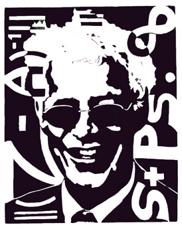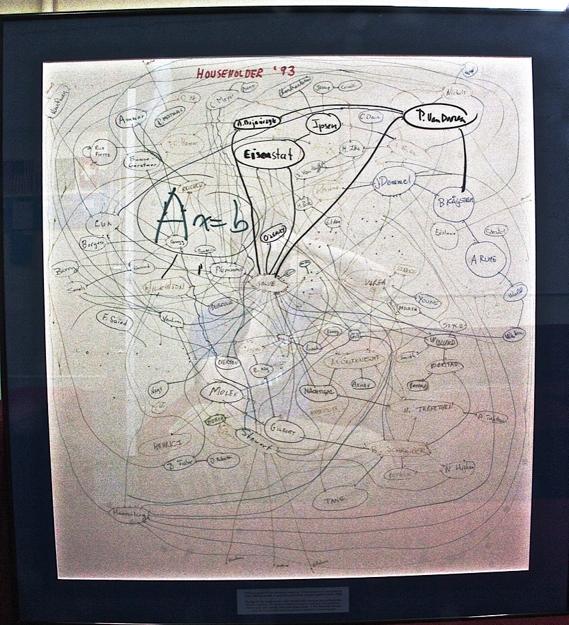Trip Report: Trefethen Birthday Conference
"New Directions in Numerical Computation" was a conference in celebration of Nick Trefethen's 60th birthday held August 25-28 in the new Andrew Wiles building, which houses the Mathematical Institute of the University of Oxford.

Photo by Sara Kerens
Contents
Nick Trefethen
Nick Trefethen is Professor of Numerical Analysis and Head of the Numerical Analysis Group at the University of Oxford. But he is an American. He was born and raised in Massachusetts. He was educated at Harvard and Stanford. He held faculty positions at NYU, MIT, and Cornell before he was appointed to the chair at Oxford in 1997.
And, as was mentioned several times at the conference, in 1984 when he was a professor at MIT, he had the institute purchase the very first license for MATLAB. Framed copies of the purchase order are displayed prominently in both his office at Oxford and the MathWorks offices in Natick.
Serra House, Stanford, 1979
Serra House was built in 1923 on the Stanford campus to be the retirement home for President David Starr Jordan. By the late 1970's it had been assigned to the Computer Science Department and housed the Numerical Analysis group. Professors George Forsythe and Gene Golub had their offices there at one time or another, as did various grad students, post docs, and visitors. There was a nice patio and volley ball court and a strong feeling of camaraderie in the Serra House group.
In the academic year 1978/79 a particularly strong group of grad studies was working in Serra House. Nick Trefethen was one of them. Three others also went on to distinguished academic careers and were plenary speakers at this conference. Marsha Berger and Michael Overton are both professors at NYU, and Randy LeVeque is a professor at the University of Washington. There were others, but they weren't at this meeting, so I won't try to list them.
In 1978/79 Gene Golub was away from Stanford on sabbatical and I was asked to be a visiting professor to fill in for him. I taught the graduate numerical analysis course and, among many other topics, used my new Fortran "matrix laboratory". It was then a primitive matrix calculator. There were no m-files, no toolboxes, no graphics. It was not impressive numerical analysis nor impressive computer science.
As I recall, Nick and Randy were enrolled in that course and Marsha and Michael sat in sometimes. This was all their first exposure to MATLAB, but it would have to become a more mature tool before they would find it useful. (It would be five years before Nick would place his order.) On the other hand, a few grad students from engineering took my course and found even that primitive MATLAB useful for work in areas like control theory and signal processing, areas that I knew nothing about at the time. That eventually led to Jack Little and to MathWorks, a story that we've told elsewhere.
Andrew Wiles Building, Oxford
The venue for the conference was spectacular. The Mathematical Institute is housed in the Andrew Wiles building, which was dedicated in October, 2013. To really see the building, Click on this link and watch the three videos.
The building is named after the British mathematician who famously proved Fermat's Last Theorem in 1995. He was at Princeton at the time, but later returned to Oxford. For his work he won a million dollar prize from The Clay Mathematics Institute. The same institute is the primary donor for the building.

Of particular interest to the MathWorks is the glass "ceiling" of the south atrium shown in the above photo. Like our company logo, the shape of the covering is a triangulation of an eigenfunction of the two-dimensional Laplacian. So it is also a frozen vibrating membrane.
Other mathematical objects are featured in the building. The covering of the north atrium is the complete bipartite graph $K_{3,3}$ of connections between two sets of three points. The area in front of the main entrance is a Penrose non-periodic tiling laid out in granite slabs inset with stainless steel bands.
Group photo
Peter Hudston took this group photo, also showing off the inner walkways. Nick and I are in the front row at the lower left. MathWorks' Penny Anderson, one of the other plenary speakers, is just behind Nick.

Photo by Peter Hudston
The admittedly incomplete list of participants on the conference web page lists 122 attendees.
The Talks
There were nineteen 45-minute plenary talks, each with some connection to Nick's mathematical work, as well as remembrances and personal connections.
- Nick Higham, University of Manchester, "Recent Progress on the Nearest Correlation Matrix Problem"
- Volker Mehrmann, Technical University of Berlin, "Stability Radii and Pseudospectra of Structured Dynamical Systems"
- Alan Edelman, MIT, "The Julia Computing Language"
- Marsha Berger, NYU, "Can Embedded Boundary Grids Compute High Reynolds Number Flow?"
- Andre Weideman, Stellenbosch University, "The Shortest Path: Complex Detours in Real Computation"
- Bengt Fornberg, University of Colorado-Boulder, "Radial Basis Function Generated Finite Differences"
- Michael Overton, New York University, Investigation of Crouzeix's Conjecture via Nonsmooth Optimization"
- Andy Wathen, University of Oxford, "Optimal iterative solution of nonsymmetric Toeplitz systems"
- Ian Sloan, The University of New South Wales, "The high dimensional frontier"
- Anne Greenbaum, University of Washington, "Near Normal Dilations of Nonnormal Matrices and Linear Operators"
- Jean-Paul Berrut, University of Fribourg, "Linear barycentric rational interpolation with guaranteed degree of precision in two dimensions"
- Mark Embree, Virginia Tech, "Approximation Theory for Model Reduction"
- Penny Anderson, Mathworks, "From a vibrating membrane to tricorders: The inextricably intertwined story of algorithms, MATLAB, and Nick Trefethen"
- Randy LeVeque, University of Washington, "How to Fit a Square Peg in a Round Hole"
- Folkmar Bornmann, Technical University of Munich, "The SIAM 100-Digit Challenge - O(10) Years Later"
- Gilbert Strang, MIT, "Stability of Interpolation: Lagrange, Shannon, Hermit"
- Leslie Greengard, New York University, "Layered medium Green's functions for wave scattering problems"
- Jon Chapman, University of Oxford, "Conformal maps, Escher, and my Dad's Christmas present"
- Des Higham, University of Strathclyde, "Keeping the Noise Down"
There were also 62 contributed 25 minute talks delivered during 12 parallel sessions with five or six talks in each session.
Thanks
MathWorks was one of the sponsors of the conference. The other sponsors were the European Research Council, SIAM, Springer, and the Mathematical Institute of the University of Oxford.
The organizers were Toby Driscoll, Endre Suli, Helen Taylor, and Alex Townsend. Helen did a particularly fine job with many details.
I had a terrific time. Thanks to all involved.









コメント
コメントを残すには、ここ をクリックして MathWorks アカウントにサインインするか新しい MathWorks アカウントを作成します。